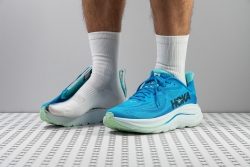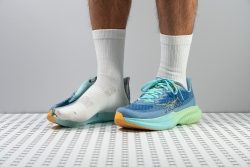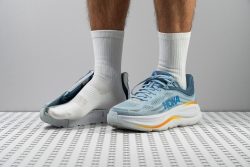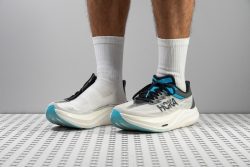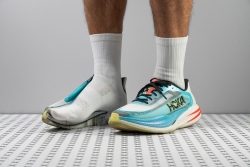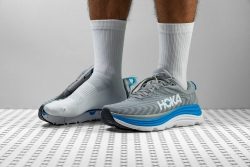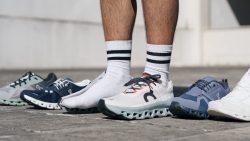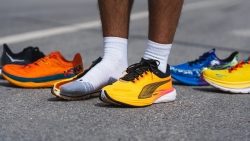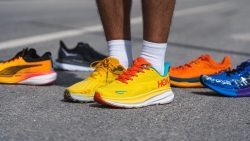7 Best Hoka Running Shoes in 2025
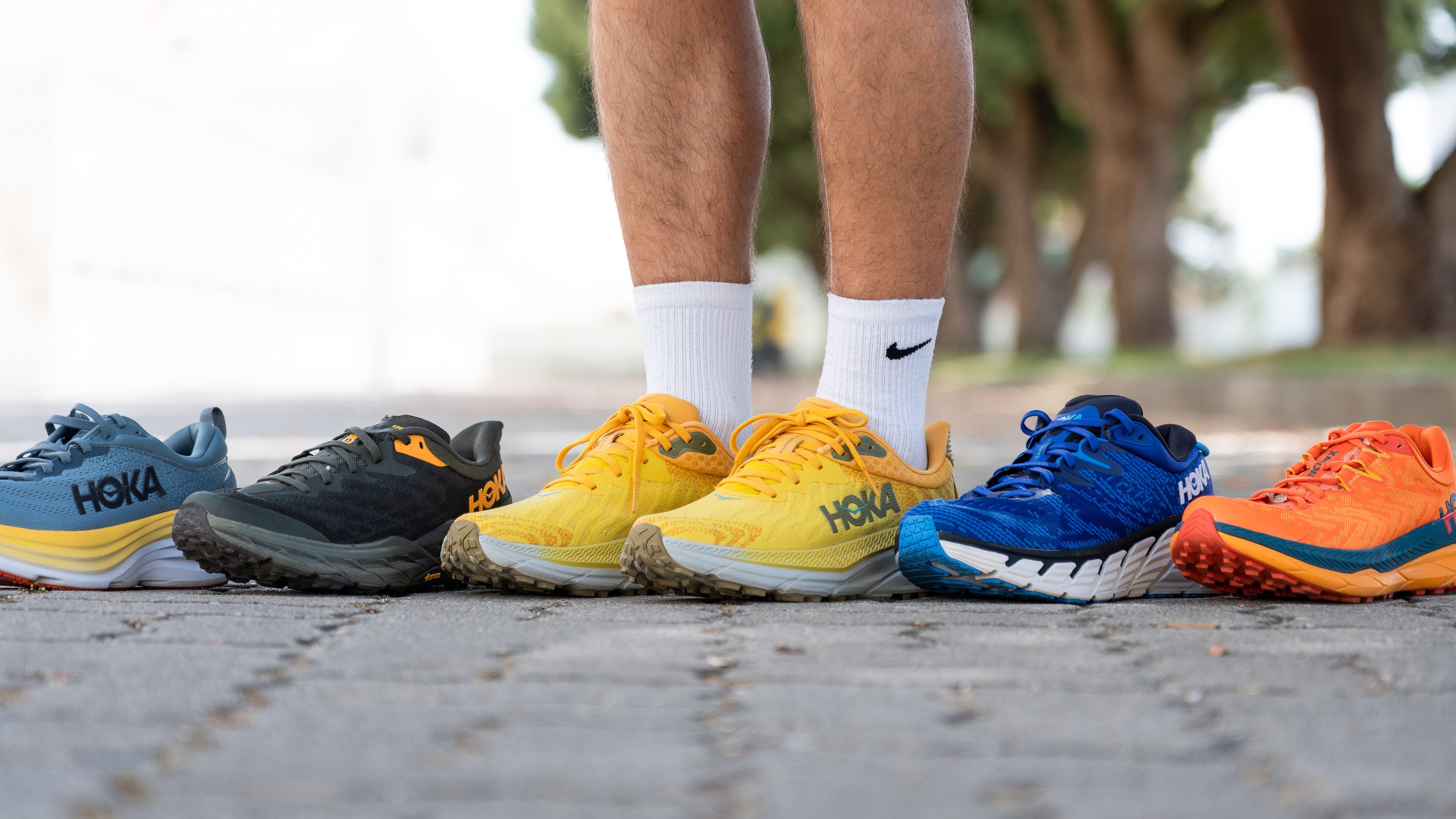
We buy shoes ourselves. We earn commissions when you buy through us, at no extra cost. Why trust us
If you want a pair of shoes with bottomless cushioning, Hoka is the right direction to take. With its highly popular Clifton and Bondi series, this is one of the go-to brands for extra cosy daily trainers and recovery-day shoes.
We are aware that the brand keeps evolving and introducing a wide range of speed-oriented shoes too. More than a few carbon-plated race shoes have been released by Hoka! (Look for shoes with an "X" in their name). With dozens of various Hoka running shoes on the market, how do you find the perfect match? This is where we enter.
At RunRepeat, we are constantly on the lookout for fresh Hoka releases. We put every new shoe through the wringer in our lab to come up with top picks in various categories.
How we test Hoka running shoes
First and foremost, we buy all Hoka running shoes with our own money to stay unbiased. That way, we can remain in control of our testing process and be transparent in our verdicts.
Our testing method involves multiple steps:
- We run in these Hoka shoes to get a good feeling of them. We vary our runs by getting the miles on the road, trail, and treadmill.
- We measure every imaginable characteristic, such as shock absorption, energy return, flexibility, breathability, and toebox space, among 30 other parameters.
- We slice each shoe into pieces to take an even deeper look at its design peculiarities.
Best Hoka running shoes overall
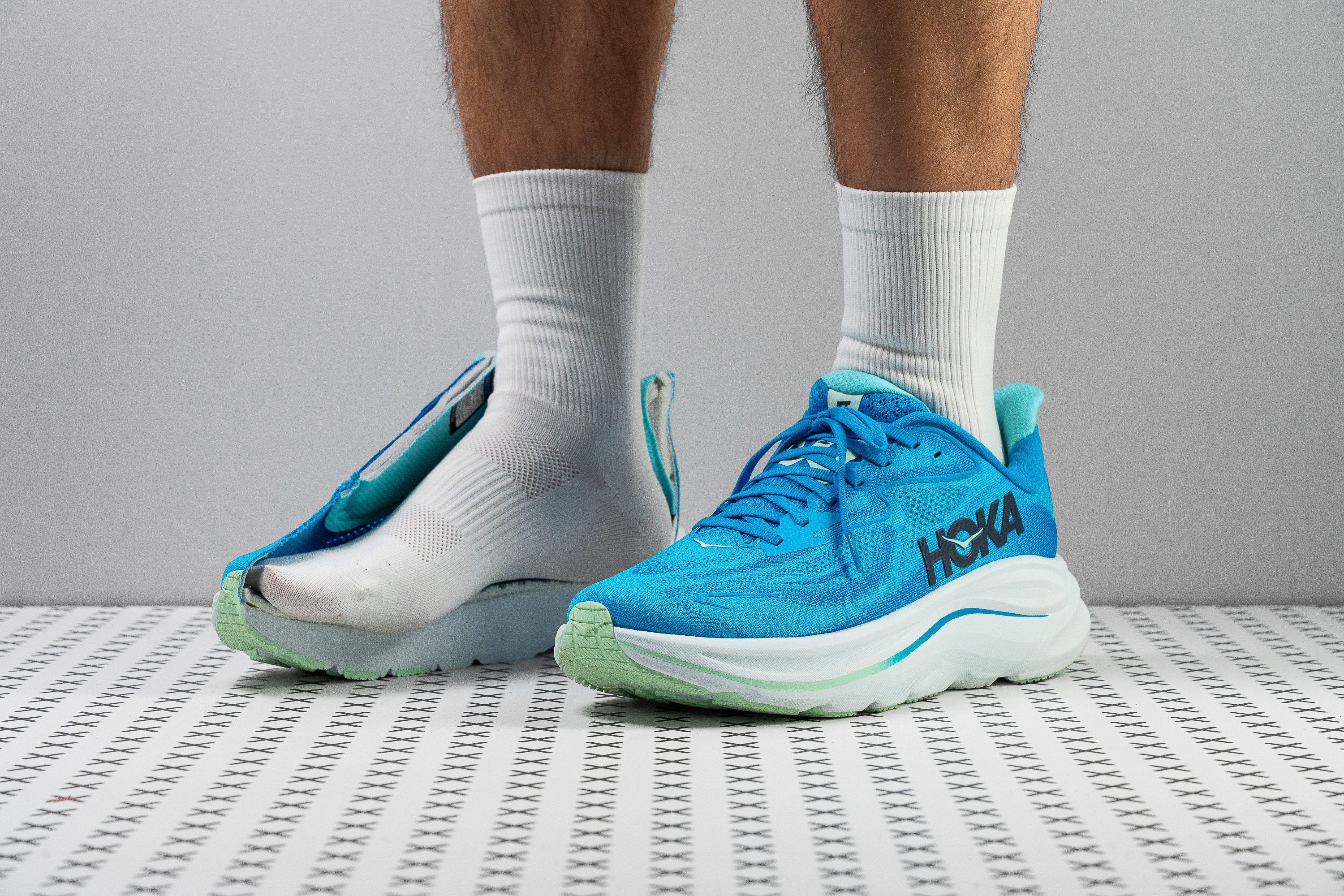




















































What makes it the best?
The Hoka Clifton 10 is definitely a stand-out workhorse due to its top-notch versatility, luxurious comfort, and solid landings. While our feet loved wearing these shoes on our runs, the lab numbers sealed the deal and led us to award it as the best Hoka running shoe.
Its versatility is unparalleled in the Hoka running stable. It's surprisingly flexible despite its thick stack, emerging 6.7% more bendable than average in our flex test. We could easily use it as a travel or walking shoe, especially with its light 9.7 oz (275g) weight for its size.
True to Hoka fashion, it features a prominent slab of soft midsole foam that provides 5-star comfort during our runs. Its remarkable softness delivers unmatched relief, emerging 18.2% softer than average. Measuring the stack at a massive 44.4/34.2 mm, its maximum cushioning absorbs impact and avoids unnecessary strain on our legs.
Despite lacking traditional stability elements, this shoe is pretty stable. Its wide platform, combined with a good upper lockdown and extended sidewalls, provides stability and support. The midsole measures 116.9/97.8 mm, more than enough space to secure our landings.
With a 3/5 score on our breathability test, the Clifton 10 may not be recommended for long runs during hot summer days. We recommend using it in cooler conditions or choosing a lighter colorway.
Pros
- Superb joint protection
- Wider toebox improves toe splay
- Comfortable upper
- Stable ride despite its high stack height
- Works well for heel strikers
- Ideal for long runs
- Versatile for daily walking or jogging
- Achilles-friendly heel collar design
- Traction improvements
Cons
- Needs a better foam ASAP
- Notable weight gain from v9
- Feels more Bondi than Clifton
- Non-gusseted tongue
Best daily training Hoka running shoes
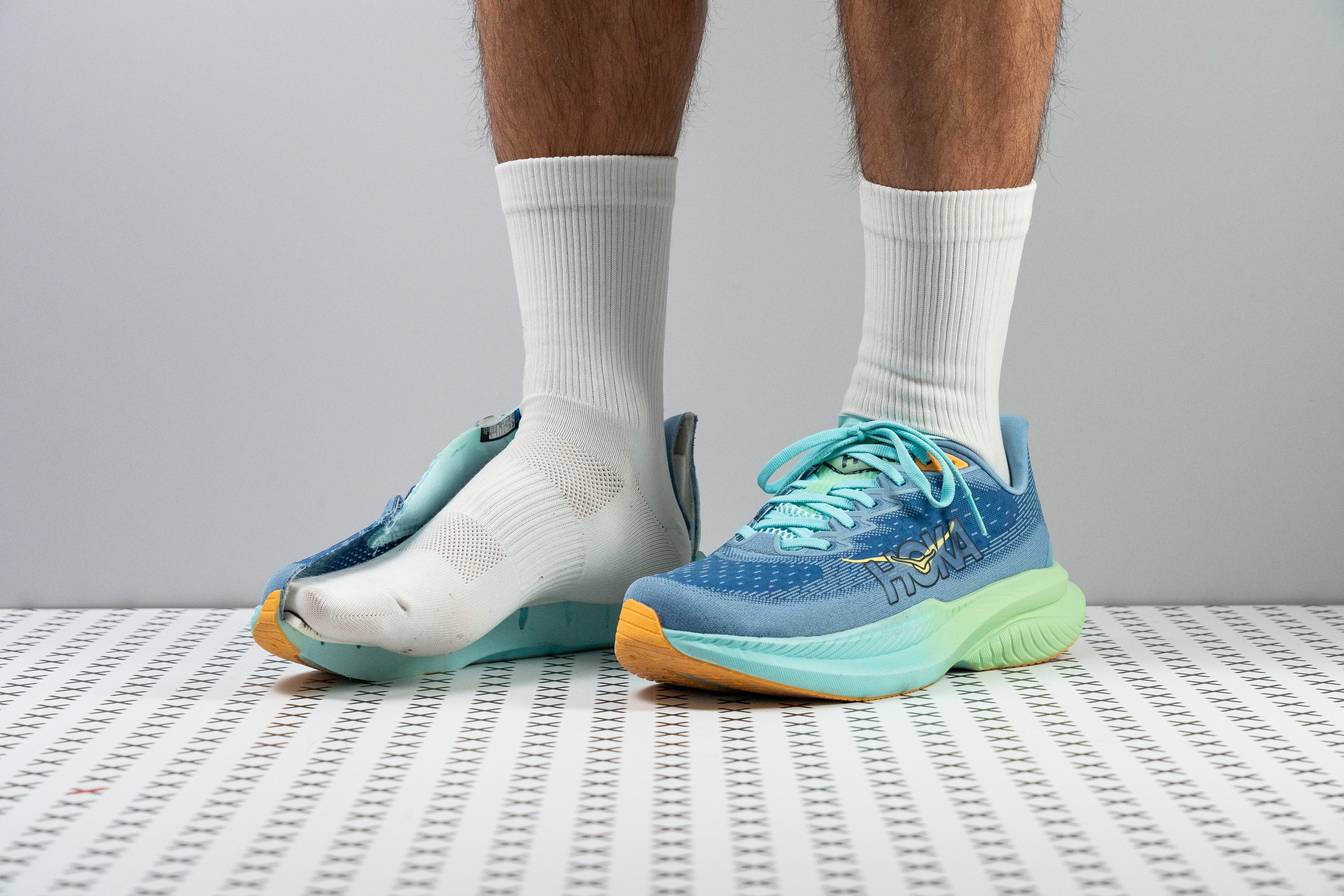























































What makes it the best?
Among Hoka running shoes we put to the test in and out of the lab, the Mach 6 hits the sweet spot as a well-rounded and capable workhorse—leading the pack as the best daily trainer. Its features are perfectly balanced, providing responsiveness for speed sessions and cushioning for long miles. It’s a breath of fresh air, with its light and loose build making every stride effortless.
Weighing only 8.2 oz (232g), the Mach 6 is a featherlight companion, tipping the scales 12.5% below average. Its airy design makes our paces feel effortless, whether tackling intense efforts or embarking on recovery runs.
What truly sets the Mach 6 apart is its energetic responsiveness. The rocker geometry, paired with a bouncy midsole foam, delivers a lively ride with smooth transitions. Adding to its allure is the exceptional comfort provided by the generous cushioning, which our calliper measures at 36.0/26.4 mm.
Further delivering a weightless feel is the unresisting midsole, which emerged 36.4% more flexible than average in our bend test. This translates to a more natural feel, enhancing comfort since we don’t have to fight much resistance.
Unfortunately, Mach 6’s effort to maintain its agility and light build is by keeping its midsole slightly narrow. We recommend wide-footed runners to check for more accommodating trainers.
Pros
- Really lightweight
- Fantastic outsole
- Exciting ride
- Highly cushioned
- Great for heel strikers
- Handles faster paces
- Superb lockdown
- Excellent value at $140
Cons
- Drop varies from stated
- Tapered toebox
- Thin tongue
Hoka running shoes with the best comfort
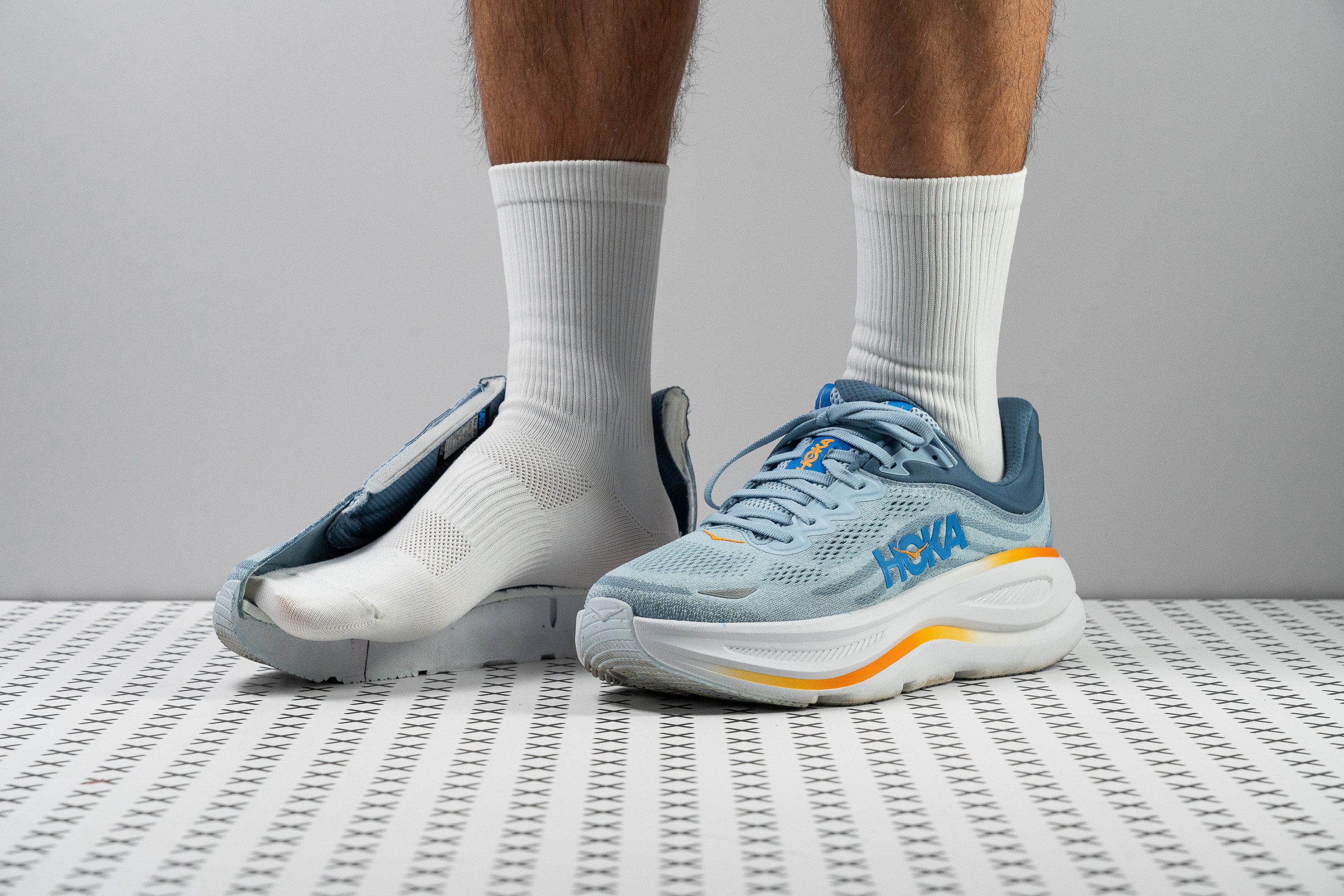



















































What makes it the best?
The perfect shoe with top-tier comfort delivers a plush and forgiving ride, and that’s exactly what Bondi 9 delivered in our runs among our lab-tested Hoka running shoes. Its heavenly cushioning is nothing short of extraordinary, ensuring our legs get all the TLC (tender loving care) we need to keep going. With an added boost of bounce and stability, the mile markers melted away.
Bondi 9 serves as a place of solace, keeping our feet in a comfortable position at all times. No matter where we land, a massive cushion awaits, with a towering 41.3 mm in the heel and 32.2 mm in the forefoot. The foam itself reduces the impact of road running better than the standard, evidenced by stellar shock absorption scores of 146 SA (heel) and 133 SA (forefoot).
Even with all the pillowy goodness, Bondi 9 adds a touch of rebound to our strides, making the ride more effortless and enjoyable. To offset the cushioning’s height, Bondi 9 has elevated midsole sidewalls to maintain our centeredness. Further boosting an anchored feeling is its vast landing base of 123.2/100.9 mm.
However, the upper doesn’t mimic the wide base and has a tight fit, confirmed by our below-average measurements. Those with medium-to-wide feet should check alternatives for better comfort.
Pros
- Endless cushioning
- New supercritical EVA midsole
- Amazing step-in comfort
- Doubles as a walking shoe
- Stable for its height
- Built to last
- Excels at slow-and-steady paces
- Well-designed heel collar
- Lighter than v8
Cons
- Not for wide feet
- Still feels heavy and clunky underfoot
- Drop measurement differs from stated
- Non-gusseted tongue
HOKA running shoes with the best shock absorption
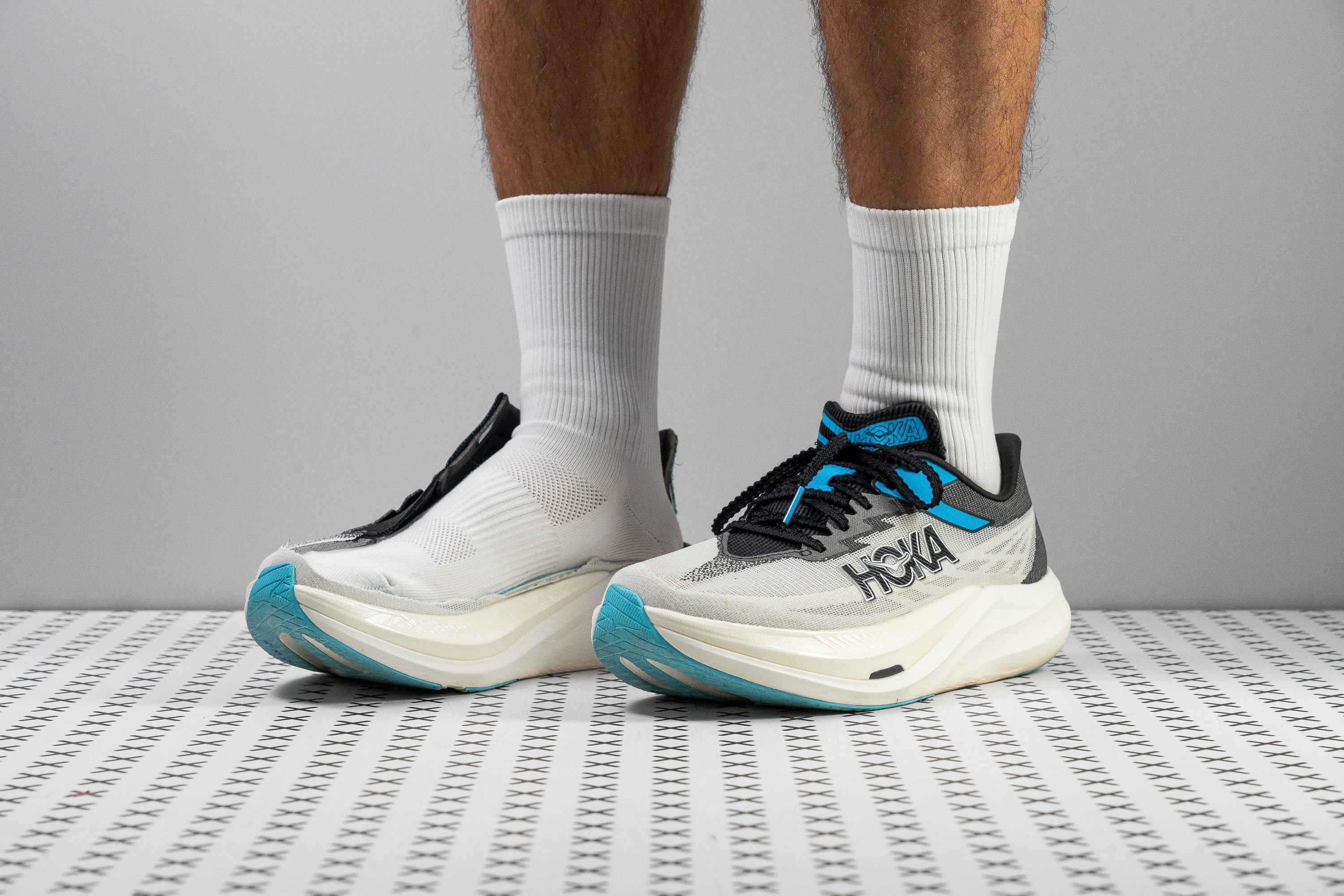













































What makes it the best?
Pros
- Fantastic durability for being a supershoe
- Responsive PEBA foam
- Built to handle marathon distances
- Rocker design promotes forward roll
- Heel stack flirts with the 40-mm limit
- Full-length, stiff carbon plate
- Higher drop benefits heel strikers
- Stable despite compact dimensions
- Comfortable heel and tongue
Cons
- Heavier than most competitors
- Tight, tapered toebox
- Aggressive rocker may not suit all runners
- Doesn't feel as fast as we hoped
Hoka running shoes with the best energy return
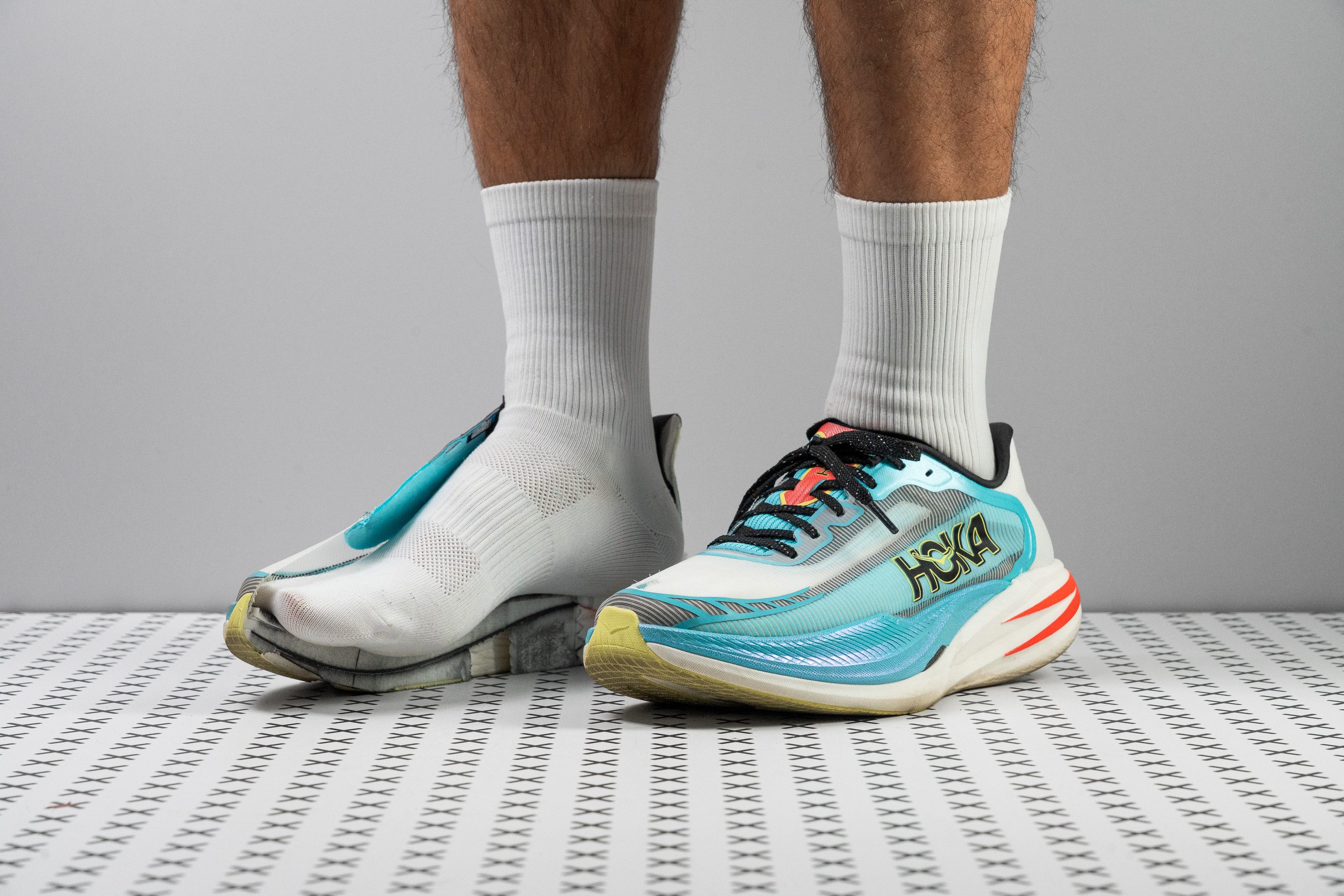

















































What makes it the best?
Extremely responsive, exceptionally cushioned, and incredibly light—these are the ingredients that make up the Cielo X1 2.0. The ride feels extra energetic and smooth thanks to its aggressive rocker and offers explosive strides through its carbon plate nestled in its responsive foam. Proven by our feet and backed up by our lab, it offers top-tier energy return in the Hoka running shoe roster.
The Cielo X1 2.0 boasts a responsive midsole foam, complemented by a full-length carbon plate for livelier strides. In our explosiveness tests, heel strikers benefit from an impressive 75.9% energy return, while forefoot strikers enjoy an even higher 78.4%, making the cushioning responsive for all types of runners.
With every landing, the midsole absorbs shock effectively. In the lab, it was rated with a high 160 SA and 108 SA in the heel and forefoot, respectively. The heavily pronounced rocker facilitates smooth transitions while the plate adds stiffness and stability to the shoe. Lab tests showed it to be an impressive 29.3% stiffer than the average.
Despite all the cushioning, it delivers a lightweight ride, proven by our scales with a 7.3 oz (208g) reading. Being 27.4% lighter than the average running shoe, it increases our agility and prevents early fatigue.
However, its rocker may feel too intense for some runners. Those who prefer a classic supershoe feel should find a pair with a more subtle geometry design.
Pros
- Much lighter than v1
- Plush and responsive PEBA foam
- Top-tier breathability
- Forked plate adds heel flex
- Comfort-focused heel padding
- Outsole durability is not a concern
- Improved upper and laces
- Works well from 5K to the marathon
- Premium TPEE insole
Cons
- Pricier than most rivals
- Rocker can feel too aggressive
- Narrow-fitting upper
Best stability Hoka running shoes
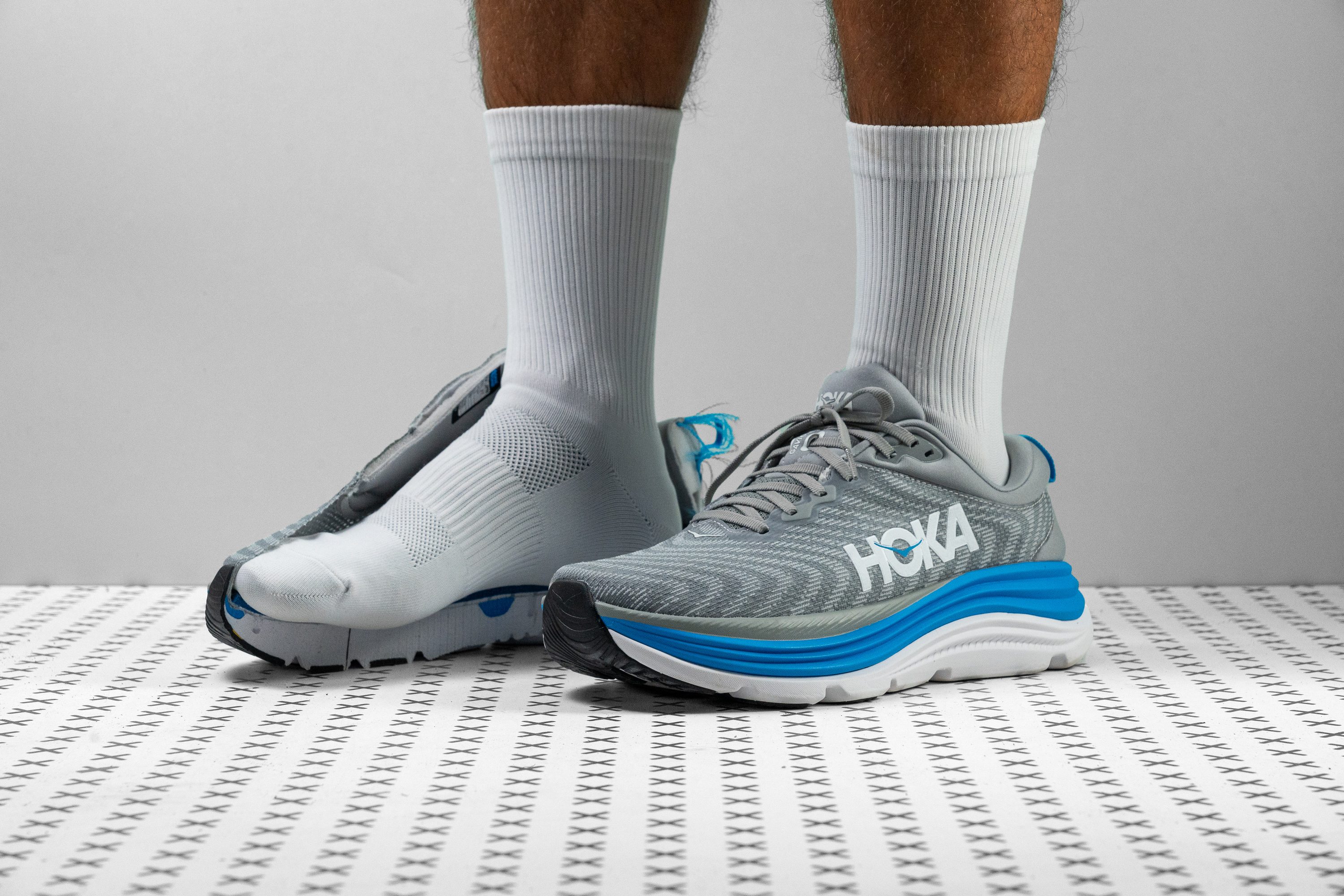


















































What makes it the best?
Hoka Gaviota’s 5th iteration exceeds the standard by smartly combining comfort with stability. Its wide base and H-Frame maintain a steady ride while the plush foam and breathable material make our runs more enjoyable. With stellar results in our lab, we’re confident this is Hoka’s best stability shoe.
Gaviota 5 offers a massive platform measuring 125.1/106.6 mm in the forefoot and heel. That’s an incredible 11.9/16.5 mm wider than average, giving more than enough space for stable landings. Coupled with the new Hoka H-Frame, it's harder to twist and helps keep the feet centred.
Its 12.9 HA midsole is one of the plushest we tested, standing 46.5% softer than average. To avoid bottoming out, Hoka integrated a firmer 22.0 HA secondary foam for additional support in the arch and heel areas. The forefoot surprisingly holds a great amount of cushion at 32.7 mm (vs 24.5 mm average), making it an ideal stability shoe for forefoot strikers.
We enjoy the breeze in this pair. Upon checking with our microscope, it has a thin mesh with hundreds of ventilation holes. This confirms the perfect score of the upper on our breathability test in the lab.
With a low 2.2 mm heel-to-toe drop, we find that Gaviota 5 isn’t the best fit for extreme heel-strikers or runners prone to calf or Achilles tendon issues.
Pros
- Remarkably stable
- Breathable and comfortable upper
- Lightweight for its size
- Good stability option for forefoot strikers
- Ideal for wide feet
- Excellent for long runs
- Excellent for long runs
Cons
- Low drop might pose issues for heel strikers
- Performs poorly in colder conditions
- Not for narrow feet
- Midsole feels flat
Best budget Hoka running shoes





















































What makes it the best?
During our lab and on-foot trials, we found the Hoka Rincon 4 to be a highly versatile shoe. Priced at just £130, this shoe offers excellent comfort and protection for short runs and gym sessions, all while being remarkably lightweight. Considering that the average Hoka road running shoe costs £160, the Rincon 4 stands out as our top budget-friendly option.
We couldn’t believe what we saw on our scales: Rincon 4 is only 8.1 oz (231g). That’s 12.8% lighter than average! Its flexible build adds to its natural feel, emerging with near-average bendability in the lab. We felt highly agile for various workouts with its effortless ride.
Despite its moderate stack, it hits above-average shock absorption ratings of 134/114 SA, making this trainer viable for long-distance training.
Its upper is a beautiful blend of comfort and durability. It breathes easily and feels soft on the foot. We awarded Rincon 4 an impressive 4/5 score on our breathability and durability tests—an exceptional result given that both elements tend to perform inversely.
However, its outsole showed one of the poorest performances in our Dremel test with its 6.5 mm damage vs. the 1.1 mm average. Runners looking for daily beaters should invest in a more durable shoe.
Pros
- Reasonably priced
- Enhanced stability
- Improved midsole over v3
- Superior breathability
- Still really lightweight
- Increased stack height
- Suitable for everyday activities
- Good traction
Cons
- Poor durability
- Low volume upper
- Weight increase
Overview of Hoka running shoes
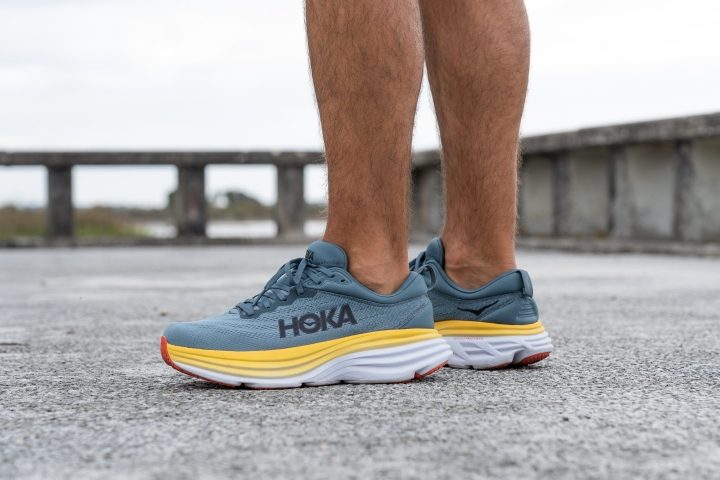
Hoka running shoes are famous for their highly cushioned and extremely comfortable design. While most Hoka shoes stay true to the brand’s maximalist roots, their product line has expanded significantly. It now includes everything from ultra plush trainers to light and responsive race day weapons.
Roads, trails, or a bit of both?
Hoka has some pretty solid options in both road and trail running shoe lines. Not to mention some excellent "road-to-trail" hybrids.
Hoka road running shoes
We recommend getting a Hoka road shoe if at least 80% of your running is done on the pavement, asphalt, tarmac, treadmill, or other hard surfaces.
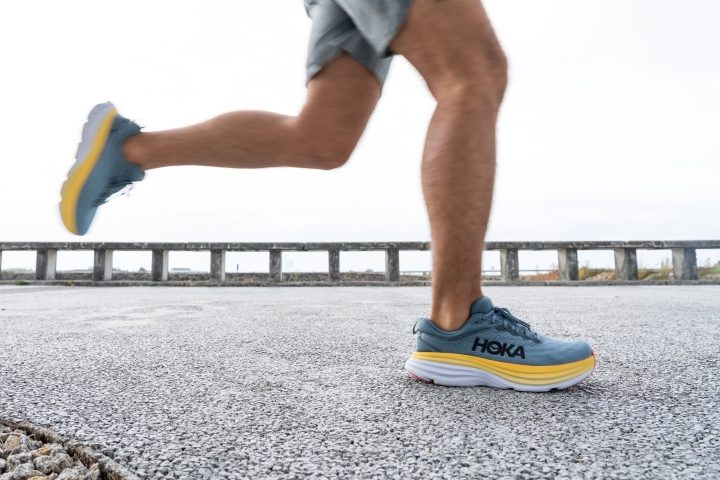
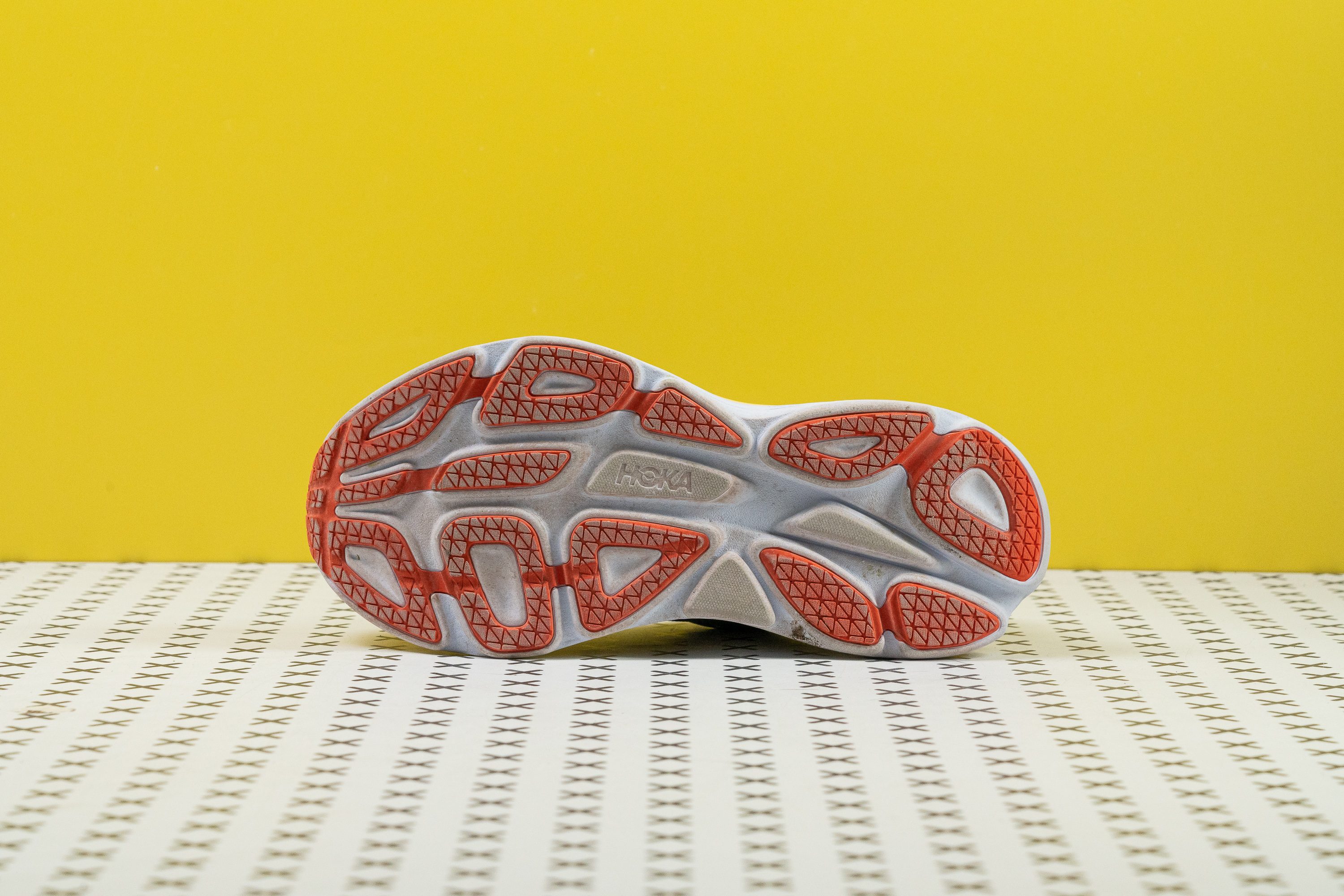
If you want to mix in some runs in the park or on light trails, consider road shoes with thicker rubber on the outsole.
Hoka trail running shoes
You definitely need a trail shoe if you mostly hit forest and mountain trails or run in the country.
Even though Hoka is most popular for its road shoes, the brand's trail-ready Speedgoat series has been a best-seller for years! And the company only keeps expanding its trail shoe selection.
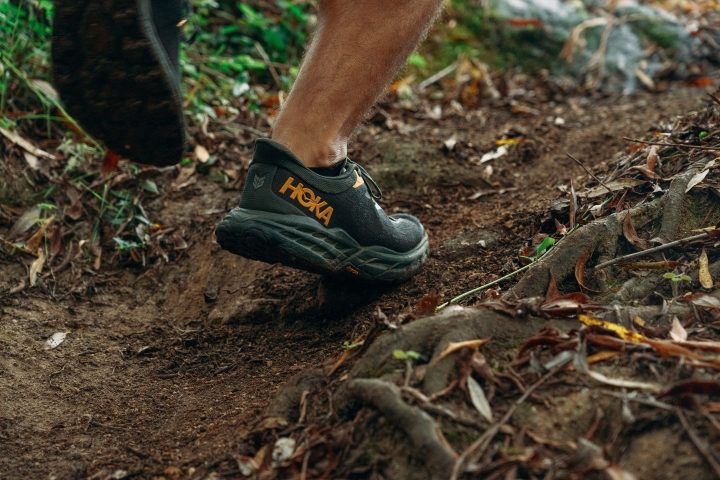
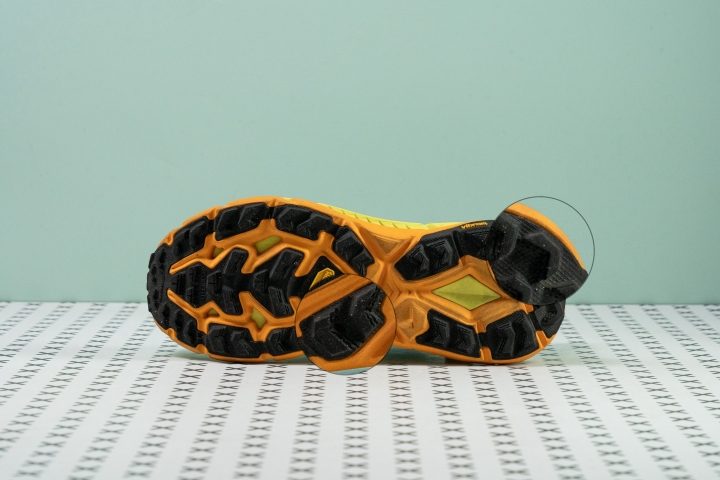
Always pay attention to lug depth and design in trail running shoes:
- Choose deeper lugs (at least 3.5 mm) for softer surfaces like grass, mud, and sand. There should also be a good amount of space in between lugs to effectively shed mud and debris.
- Choose shallower lugs (less than 3 mm) for easier, hard-packed trails made of gravel or dirt. These shoes can also be worn for short distances on the road (i.e. from door to trail).
Learn more about lugs, grip, and running shoe outsoles in our science-backed guide.
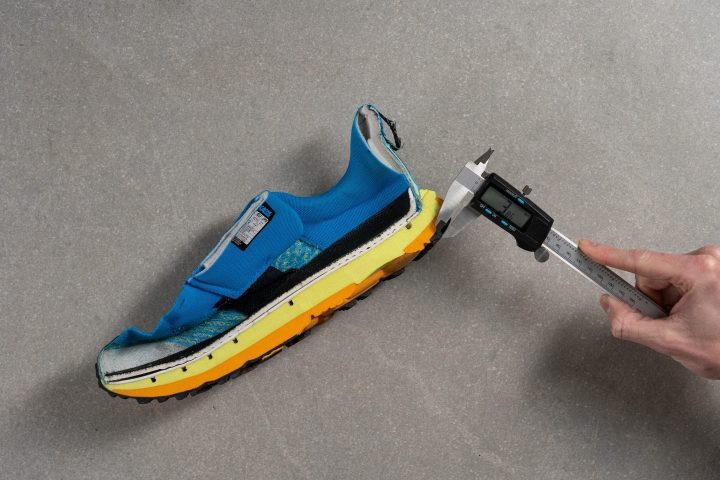
Hoka shoes for everyday runs and race days
Even though Hoka is one of the youngest brands on the market (est. 2009), it boasts a substantial selection of shoes for every type of run.
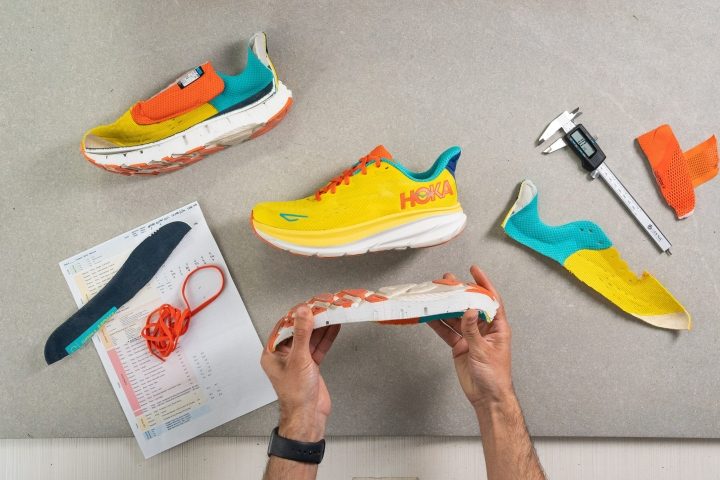
There is a spectrum, from plush everyday workhorses (Bondi and Clifton), to balanced all-round performers (Rincon and Carbon X), all the way down to responsive speedwork and race day specialists (Rocket X and Mach).
We are here to help you find the right Hoka shoe to match your athletic goals.
Daily running shoes from Hoka
If you are just starting out on your running journey, this category of Hoka shoes is right up your alley.
The brand's huge selection of daily training shoes has enough variety to meet the needs and preferences of most runners. They also make for fantastic walking shoes with their heavenly comfort.
Here is what makes these Hoka shoes so popular and lovable:
- generously cushioned midsole (30-40 mm of heel stack, 35 mm on average)
- variety of heel-to-toe drops (from 3 to 7 mm, there is one for every type of strike pattern)
- plush yet balanced cushioning
The only drawback of daily trainers is that they compromise weight in favour of more comfort and cushioning. But luckily, Hoka found a way to keep some of its daily running shoes below the average 10 oz (283g)!
Tempo trainers from Hoka
A small bunch of everyday running shoes from Hoka is made of lighter and speedier options.
Weighing only 7-8 oz (200-225g), these trainers feel much more nimble, snappy, and responsive underfoot. They also tend to have a better energy return than daily trainers.
Consider these shoes for your tempo runs and fartleks on shorter distances up to 10K.
TIP: Lighter shoes are essential for shaving seconds off your personal best. Studies show that every 100g added to a running shoe slows you down by 1%.
Race shoes from Hoka
Competitive runners looking for their next race shoe will enjoy the latest technologies packed into these Hokas.
Here are the most prominent features that make these Hoka running shoes perfect for race days:
- lightweight (7-8 oz/200-225g)
- ultra-responsive and plush cushioning (Pebax-based foam)
- aggressively rockered shape (for fast and smooth heel-to-toe transitions)
- stiff carbon plate (for added propulsion on each step)
Did you know that thanks to carbon-plated running shoes, athletes managed to break every woman and man record on every distance since 2016? In our comprehensive research on carbon-plated shoes, we explore how this unique shoe feature helps to boost running performance.
Carbon plates in Hoka running shoes
Carbon plates help maximise energy return and propulsion on every stride. They can have a noticeable effect on performance and are now fixtures in the “super shoes” of various brands, including Hoka.
TIP: Beginner runners do NOT need carbon-plated shoes as they are most beneficial on faster paces and are more expensive.
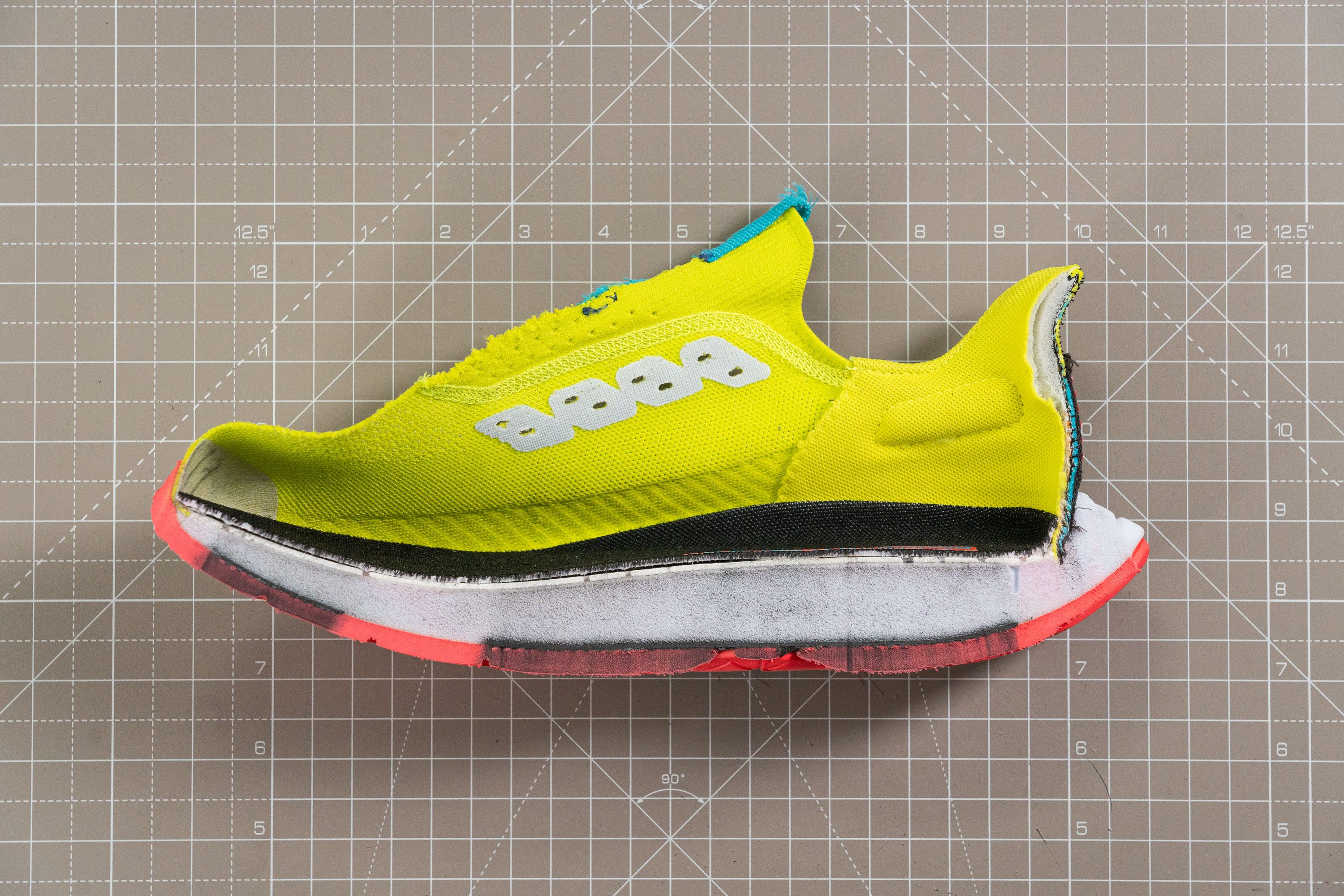
Hoka shoes with carbon plates include the Bondi X (high-cushioned propulsive trainer), the Carbon X (all-around road racing shoe), and the Rocket X (Hoka’s premier super shoe).
Hoka even has a carbon-plated trail shoe—the Tecton X. Unlike roads, where terrain and gait stay fairly consistent, carbon plates are not always as advantageous on trails. The propulsive effect can feel destabilising on steep descent or uneven and technical terrain. Carbon-plated trail shoes like the Tecton X are best reserved for races on buttery singletrack through rolling hills.
How to choose the right cushioning in Hoka shoes
At first glance, all Hoka shoes look the same: thick-soled, extra comfy, and brightly coloured. But try dipping your foot inside each one, and you will see how different Hoka shoes can feel!
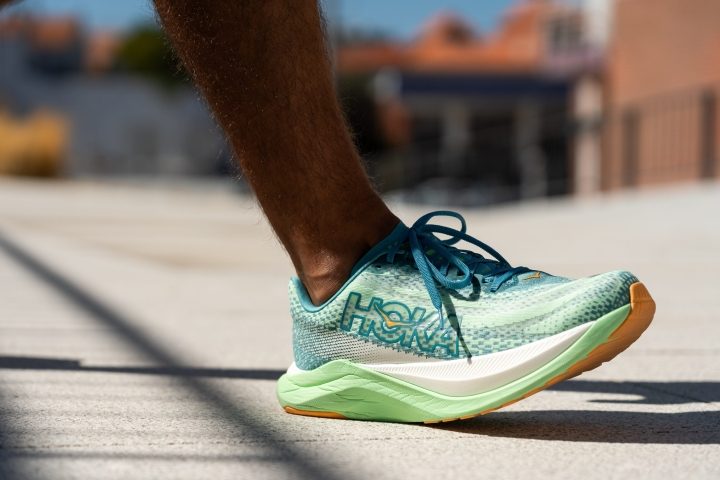
If you want to get a Hoka that works in perfect harmony with your foot and not against it, consider the following cushioning parameters:
- shock absorption
- energy return
- heel stack height (how high is the heel placed off the ground)
- heel-to-toe drop (how steep is the slope from the heel to the toes)
Shock absorption of Hoka running shoes
When talking about cushioning, many runners comment on the softness first. If you're one of those runners, you may be happy to know that Hoka doesn't have firm shoes! We found that even their firmest models are only in the "balanced" category. Overall, Hoka shoes turn out to be 13% softer than running shoes on average.
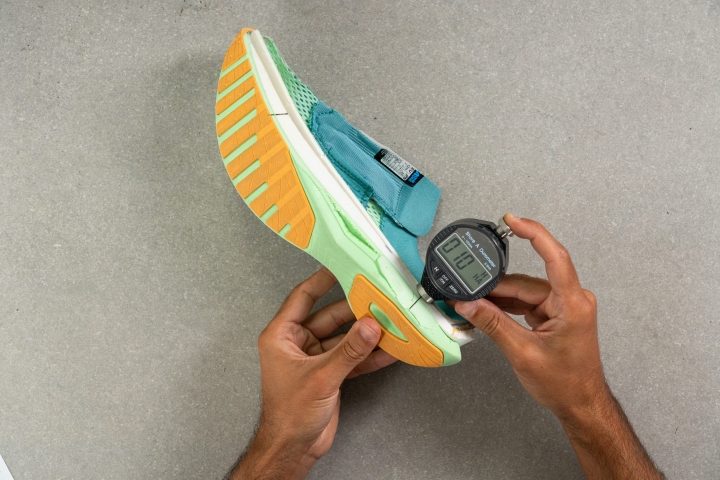
So, if softness is what you prioritise, look for lower numbers. If you prefer a firmer ride, look for a higher durometer reading. However, we think the spotlight should not be directed only at softness. Shock absorption is a very important feature because it actually tells us how protective the midsole is!
To test and quantify shock absorption, we honour the ASTM F1976 13 methodology. We drop an 8.5kg mass from a height of 50 mm, with a total energy input of 5 J. We perform this test both at the heel and at the forefoot. This way, you can look for good shock absorption exactly where you need it (where you land, depending on your foot strike).
Energy return of Hoka running shoes
While the foam can dampen the impact, that measurement (shock absorption) does not tell us how bouncy the foam is. And having shoes with a good energy return is a priority because dull foams cause premature fatigue which we definitely want to avoid.
| If you don't feel comfortable with these terms, we wholeheartedly recommend reading our in-depth guides: Energy return in running shoes explained and Shock absorption in running shoes: Explained and tested. |
Usually, race-day shoes have record-high energy return. It's not unseen for a daily trainer to score high as well!
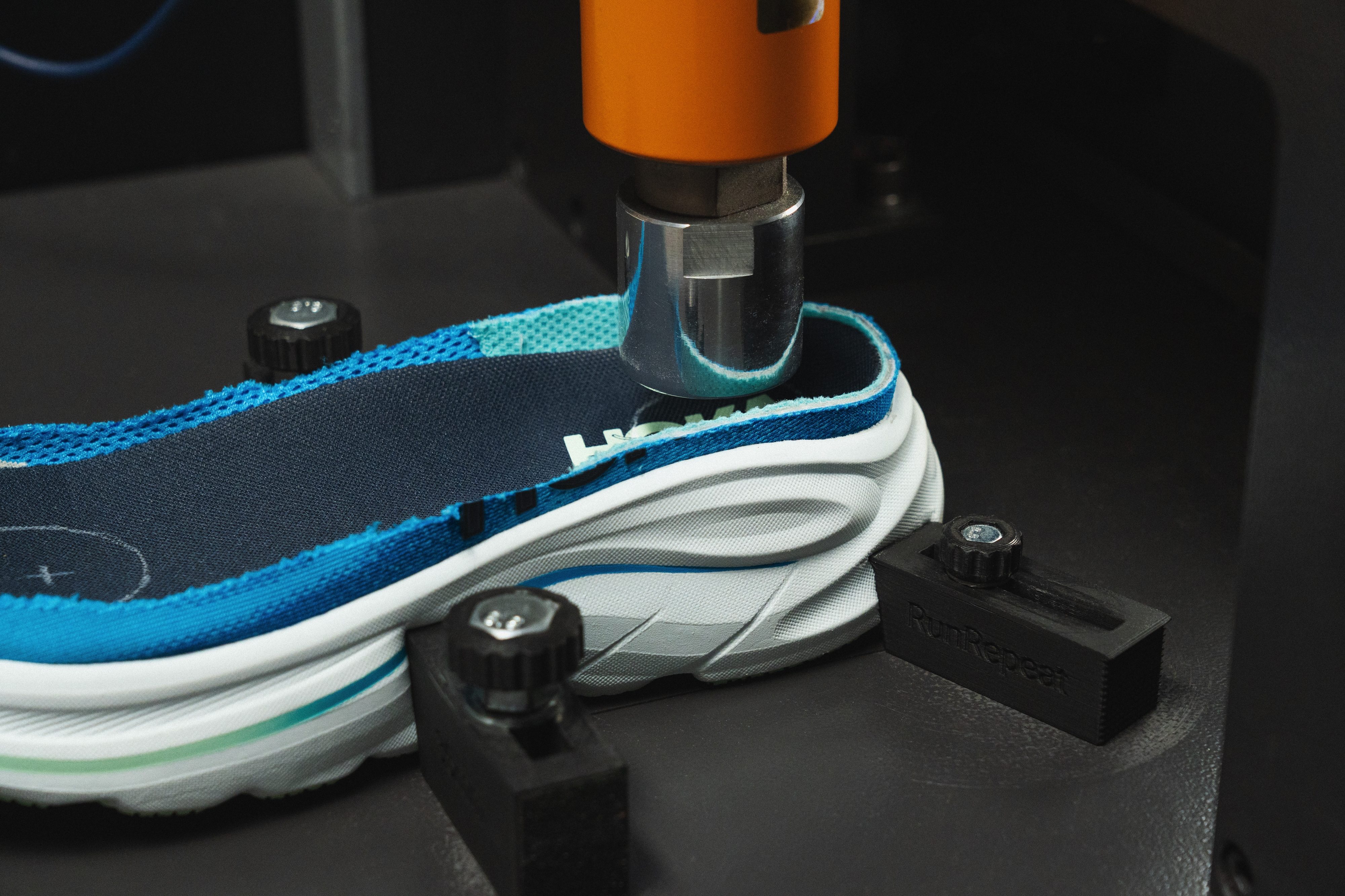
Heel stack heights in Hoka shoes
We don't even need a calliper to prove that Hoka shoes have some of the tallest stack heights among running shoes.
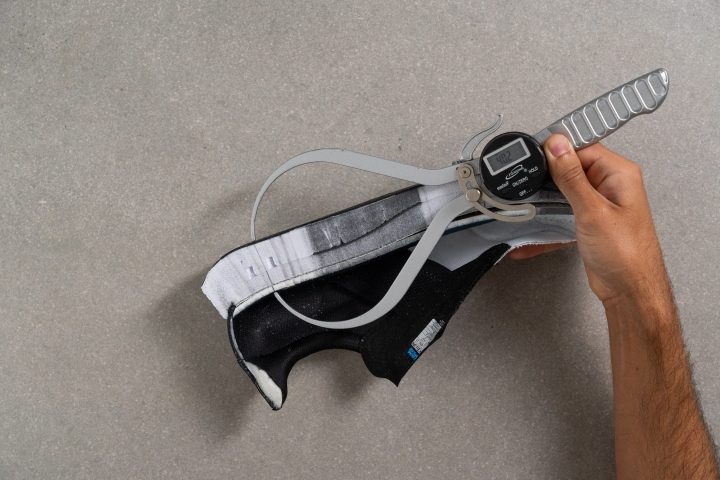
We even came across a potentially "illegal" Hoka shoe! With a heel stack of 40.2 mm, the Transport X exceeds the allowed 40 mm which means that it could be disqualified from a competition!
Based on our lab measurements, the heel stack in Hoka shoes ranges from 30 to 40 mm, averaging 35 mm. This is a few millimetres thicker than running shoes on average.
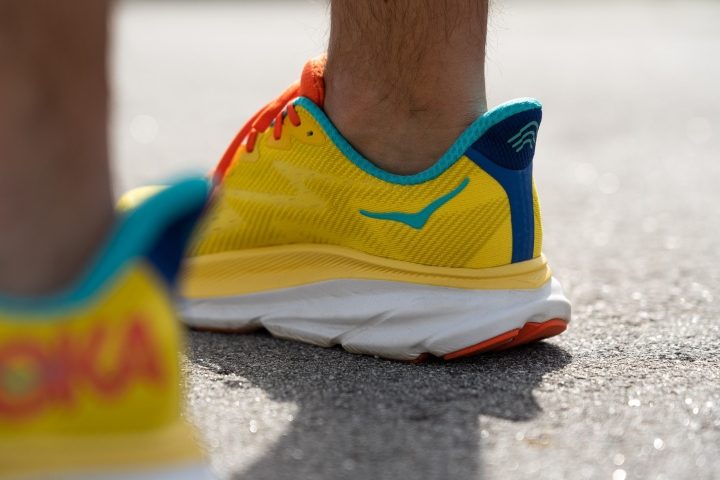
But thicker doesn't necessarily mean better. Especially for beginner runners.
To avoid straining your feet and tendons, we recommend Hoka shoes with a moderate heel stack of 30-35 mm.
A heel height beyond 35 mm is typically seen on Hoka shoes that are best for:
- slow recovery runs
- marathon and ultra distances
- elite race shoes
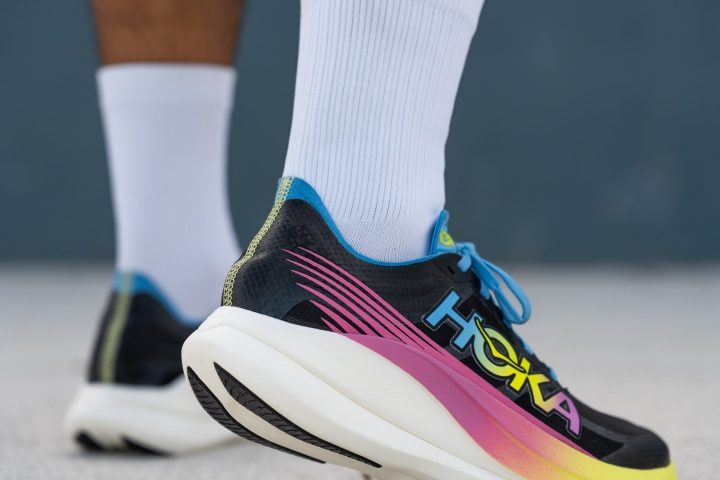
Heel-to-toe drop: a quick guide
The drop makes such a big difference that Hoka even added a filter for it on their official website.
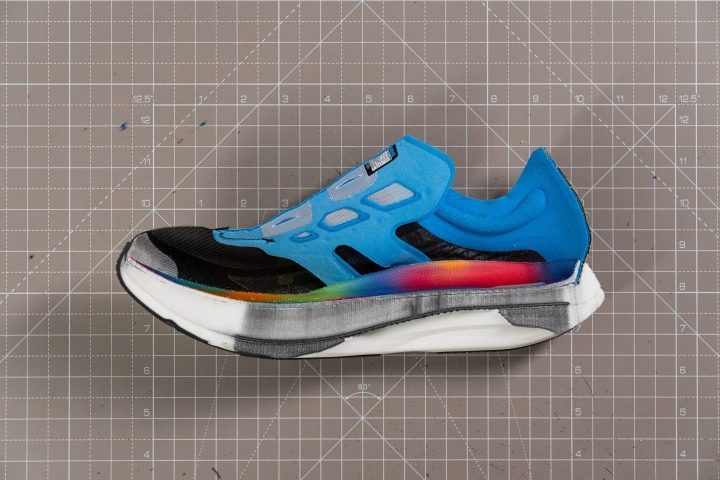
Referring to the difference in height between the heel and forefoot stacks, the drop can make or break your running experience.
As a beginner runner, you will most likely feel comfortable with a higher drop (at least 8 mm) because:
- it accommodates a heel-striking pattern (when your heel lands first followed by the midfoot and forefoot)
- it takes some load off the Achilles
On the other hand, seasoned runners are more likely to go for the lower drop (less than 8 mm) because:
- it accommodates their midfoot/forefoot striking pattern
- it has the potential to improve cadence
If you have further questions about the drop and how it affects performance, check out our extensive research on the topic.
Arch support in Hoka running shoes
You are likely to need a pair of stability shoes from Hoka if you experience the following:
- you have flat/fallen arches
- your feet tilt inwards a lot (overpronate)
- your shoes wear out more on the inner side
If you are not sure, consult a podiatrist or have a look at our detailed guides on pronation and arch support.
Example of a stability Hoka shoe with arch support
Example of a neutral Hoka shoe without arch support
There are two long-standing stability shoe series from Hoka: the Gaviota and the Arahi.
| Hoka Gaviota | A max-cushioned mile eater, the Gaviota spares nothing when it comes to stability and cushioning. It is a super comfy daily trainer for overpronators, suitable for short recovery runs and very long training sessions. |
| Hoka Arahi | The Arahi is lighter and nimbler than the Gaviota but shares its chunky aesthetic. Despite its looks, this stability shoe is surprisingly responsive and fun to run in. |
To assess the amount of stability and arch support in a shoe, we perform the following tests:
- Torsional rigidity: manual twist-and-bend test, rated on a 1-5 scale where 5 is the stiffest.
Shoes with high torsional rigidity create a steady platform and don't let the foot roll over the edge of the shoe.
- Heel counter stiffness: manual push-and-squeeze test, rated on a 1-5 scale where 5 is the stiffest
Shoes with stiffer heel counters have a better heel and ankle hold. They don't let the rearfoot slide inwards and prevent heel slippage.
- Midsole width: measured with a calliper in both the widest part of the forefoot and the heel
Shoes with extended contact points create an extra stable base to prevent the foot from rolling over.
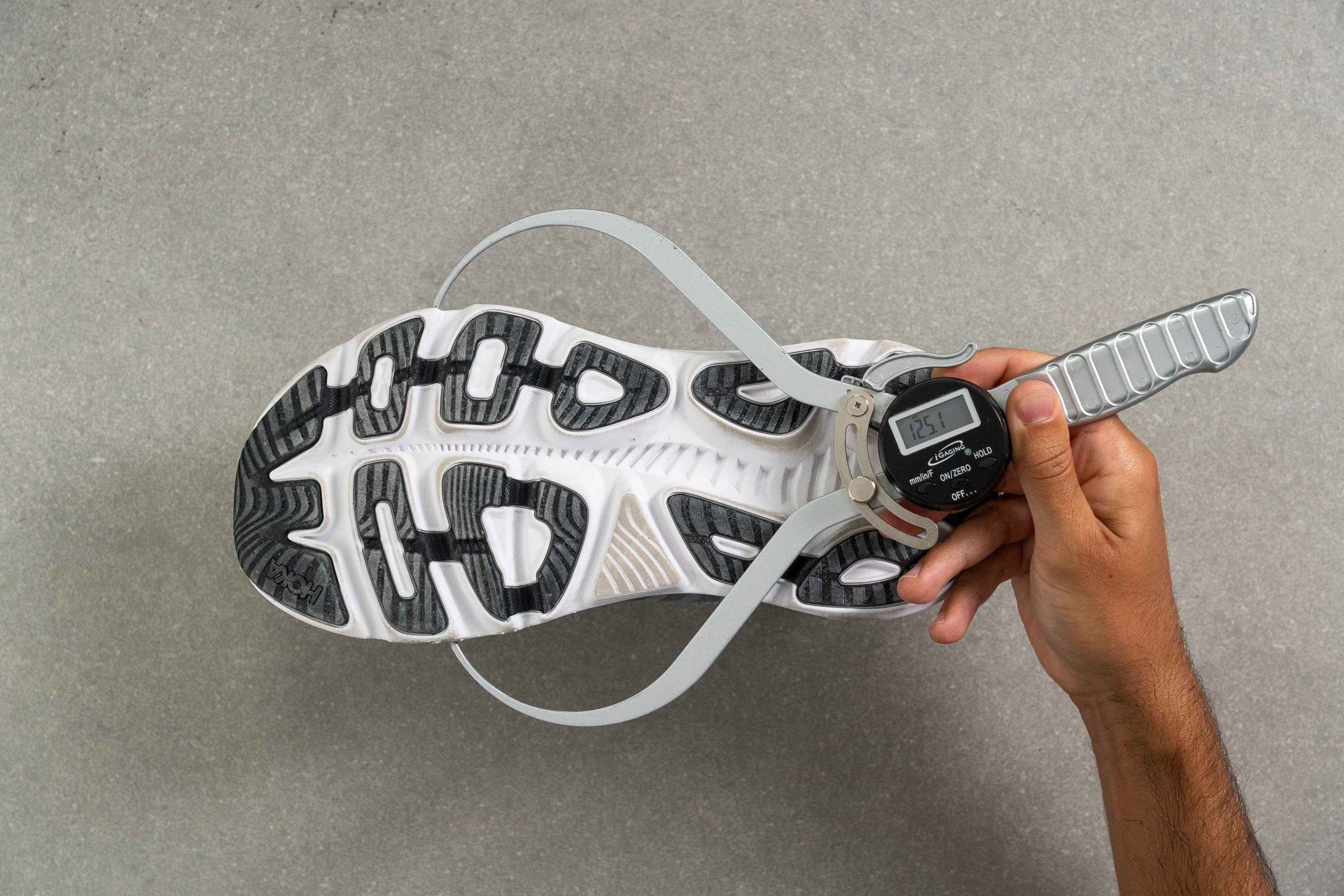
Get the right size and fit in Hoka shoes
In general, Hoka shoe sizing tends to be consistent with other major brands like ASICS, New Balance, and Brooks. But if you're ordering shoes online, you want to be extra confident to avoid returns.

First of all, we highly recommend measuring your foot length precisely. You might be surprised to find out that your feet keep growing! Then, check your corresponding Hoka size in the brand's official size chart.
In addition to getting the right size or length, you need to ensure that the Hoka shoe you choose has enough toebox width for your feet.
To get accurate measurements of the fit, we make a gel mould because it reflects the interior volume of the shoe perfectly
When the gel mould is ready, we start measuring: a) the width of the shoe where it's the widest, b) the width of the toebox at the big toe, and c) the height of the toebox.
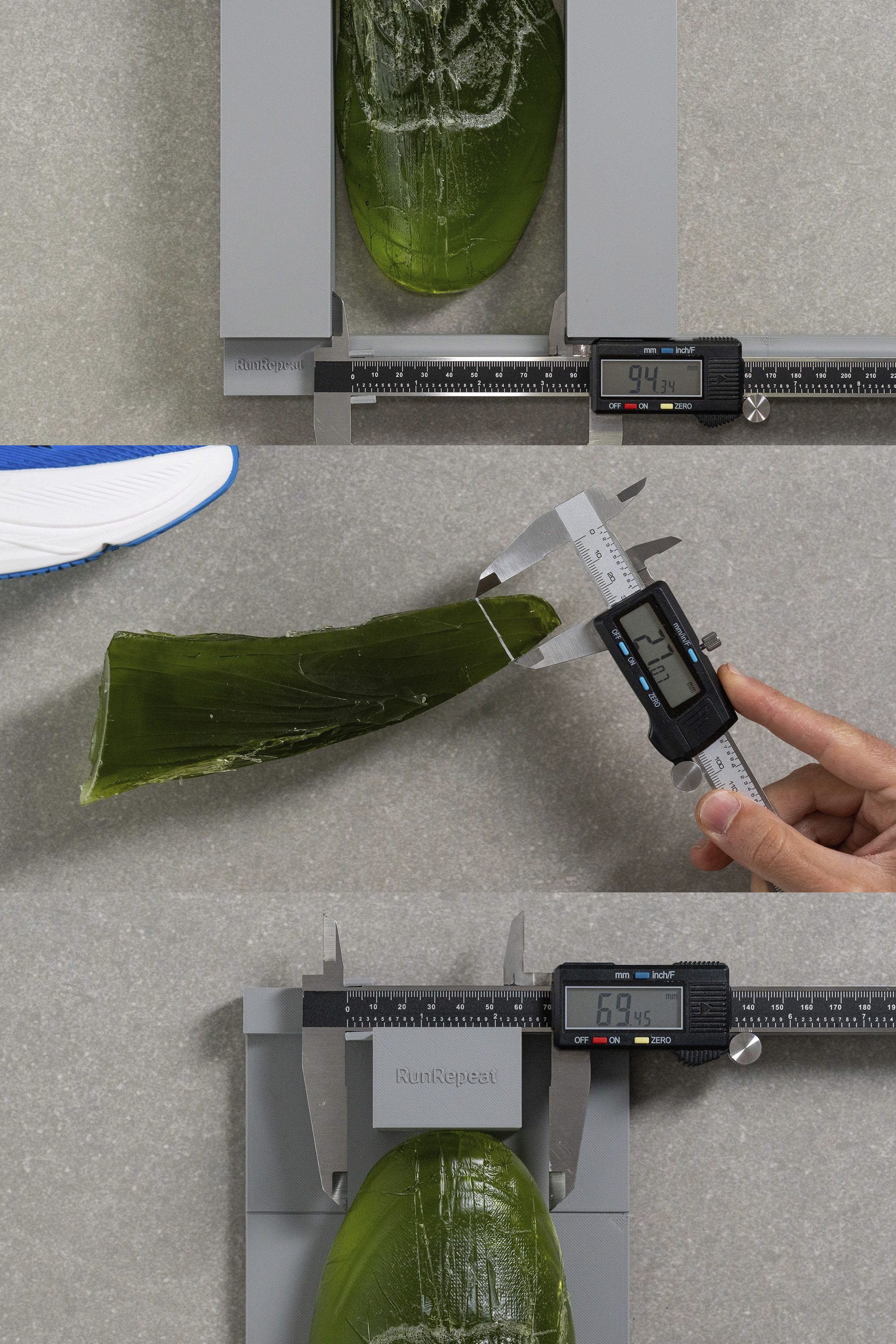
Based on our lab measurements, Hoka shoes don't have particularly wide toeboxes, but they do fit as expected for a medium width.
If you prefer Hoka shoes with a pointy toebox, look for those that are narrower at the big toe. If you need more room in that area, look for the widest Hoka toeboxes at the big toe.
If you're afraid of Hoka running shoes pressing on your toenails too hard, look for those with the highest toeboxes!
On the bright side, the brand offers some of its running shoes in wide and extra-wide options.

In addition to measuring each Hoka shoe's toebox dimensions, we also check how thick is the tongue and whether it's gusseted or not. These parameters also have an effect on the overall fit and feel of the shoe.

We also take a closer look at the upper material and how padded and stretchy it is on a given Hoka shoe.
Rain or shine: Hoka has shoes for both
Knowing how much breathability can affect your running experience, we take it just as seriously as the shoe's cushioning.
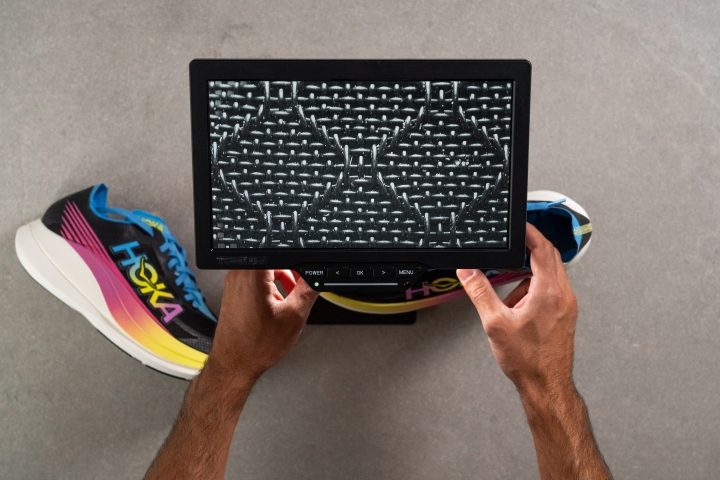
You sure want the most breathable Hoka shoes for a hot summer day. We have filtered out the airiest ones in the table below:
On the other hand, if you are braving the cold season, you may want a warmer Hoka with a thicker upper to keep you cosy:
Some Hoka shoes are endowed with a waterproof GTX (Gore-Tex) membrane. This world-class technology has outstanding waterproofing capacity without suffocating the feet.
You will need this feature if you frequently run in rain, puddles, snow, slush, and other wet conditions.
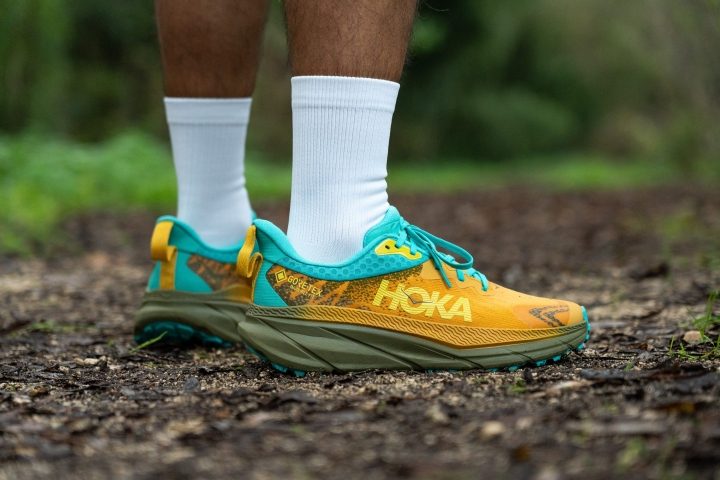
The best technologies in Hoka running shoes
All Hoka running shoes feature three core technologies, each finely tuned to offer different levels of speed, stability, and support.
Lightweight cushioning foams
Thick, highly cushioned midsoles are what most people think of first when they think of Hoka shoes.
The brand’s most recent cushioning offerings can be split into two categories:
| Standard | Premium | |
|
used in daily runners and tempo shoes |
used in race-ready shoes |
|
| ProFly (EVA) | ProFly+ (EVA) | unnamed PEBA-based |
|
|
|
| used in Mach 4 | used in Mach 5 |
first introduced in the brand's debut super shoe, the Rocket X 2 |
Based on our lab durometer measurements, the ProFly+ foam in the Mach 5 is 29% softer than the Profly in the Mach 4.
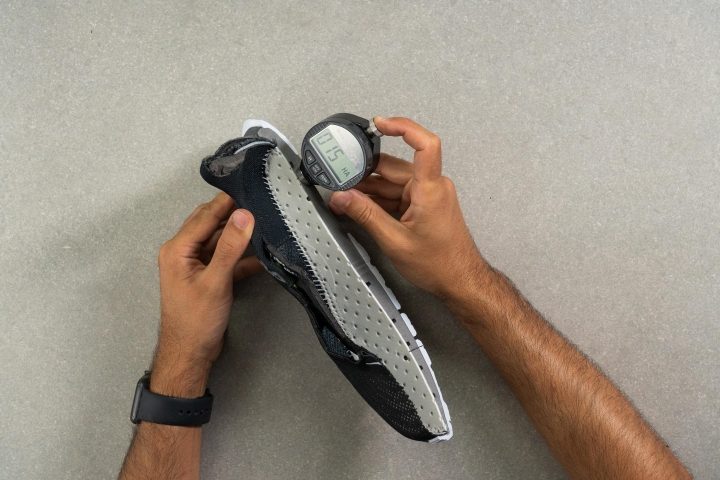
Meta-Rocker design
Hoka soles are engineered with a curved Meta-Rocker design to encourage quick and efficient heel-to-toe transition. The rounded soles and a relatively low drop (most Hoka’s have a 4 mm to 5 mm drop) create a snappy stride and prevent that “flat” feeling you get in some running shoes.
Performance-oriented Hoka running shoes have an “Early Stage” Meta-Rocker, with the rocker point located under the balls of the feet to promote fast transitions. To put it simply, the toe tip is lifted higher up in these shoes.
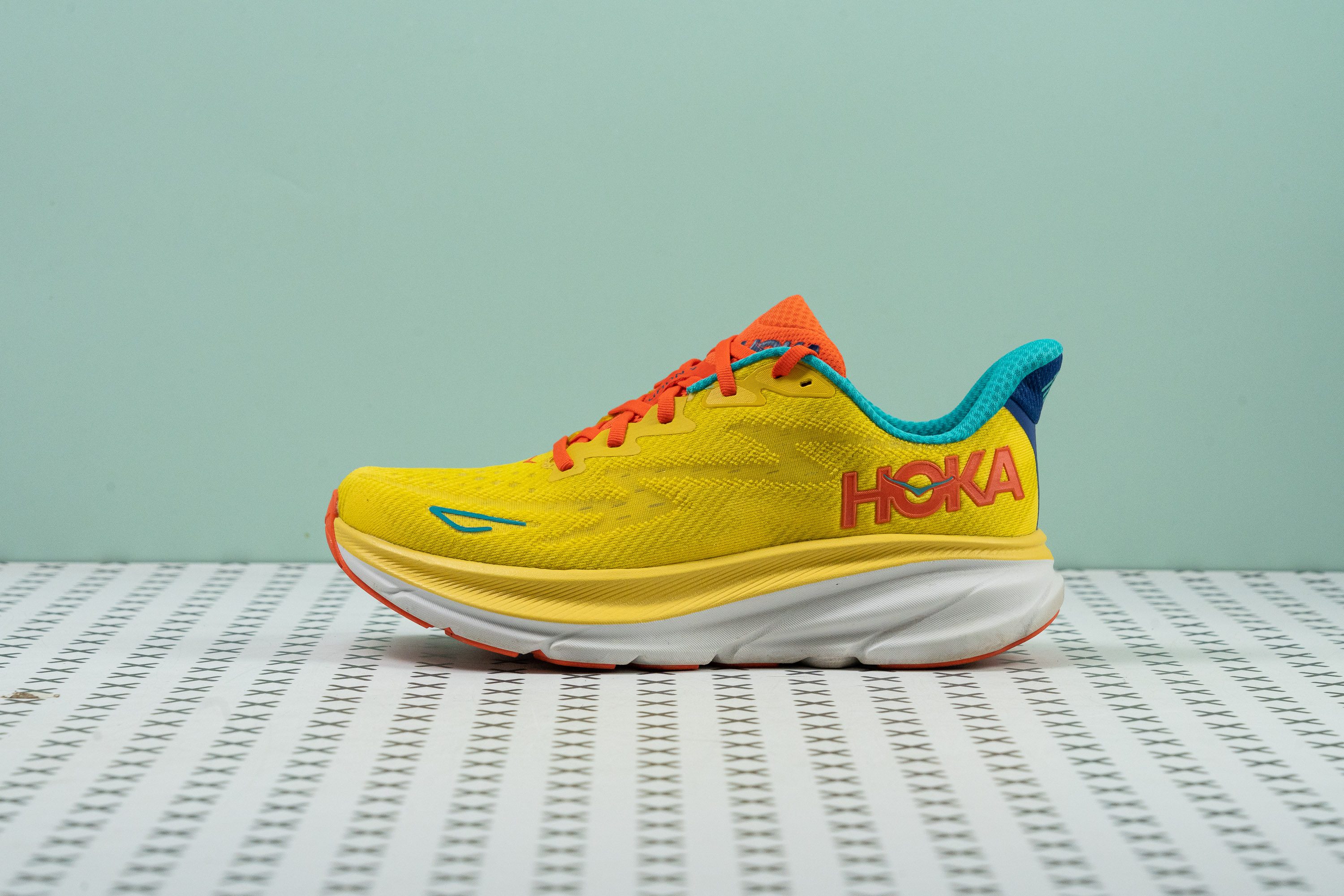
Hoka's stability trainers, walking shoes, some trail shoes, and hiking footwear all use the “Late Stage” Meta-Rocker, with the rocker point placed closer to the toebox for added stability.
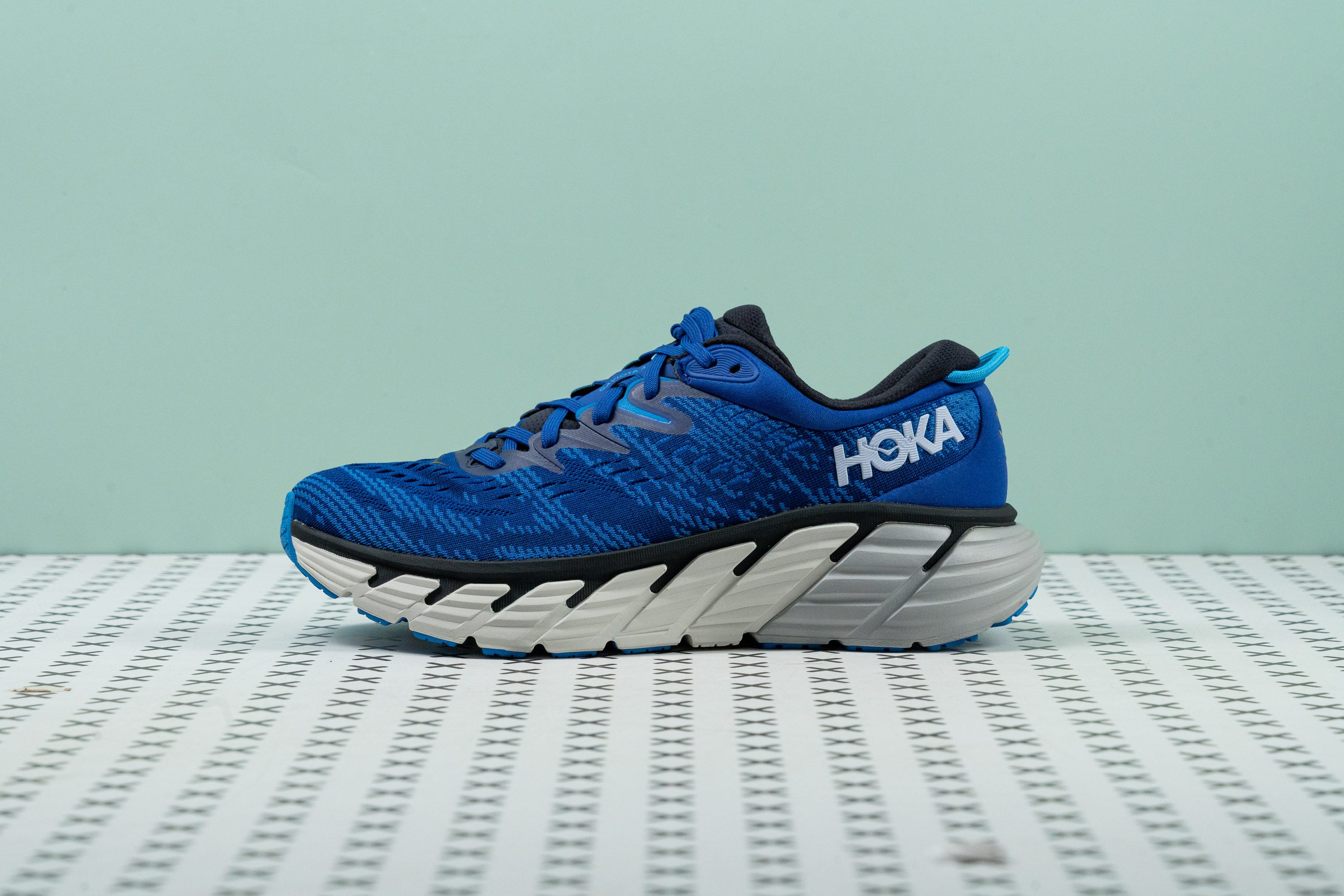
Active foot frame (J-Frame) for arch support
Some Hoka running shoes all have a deep, moulded foot frame that cradles the foot comfortably. Embedding the foot frame deeper into the midsole adds to the security of Hokas and helps the shoes feel stable, even with their characteristic ultra-high stack heights.
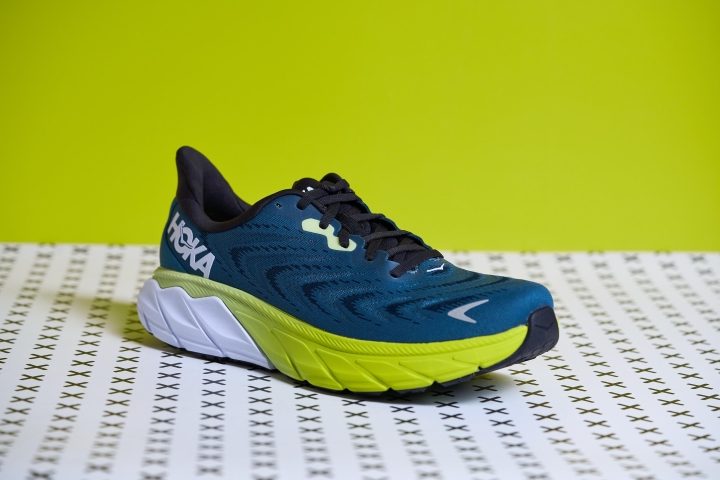
FAQs
Do Hoka shoes prevent injuries?
The thick midsole cushioning in Hoka shoes aims to provide excellent shock absorption and reduce impact on joints. High-cushion shoes may potentially lower the risk of certain injuries, but the scientific evidence is not as conclusive as shoe brands would like you to believe.
Individual biomechanics, running form, and smart training play bigger roles in injury prevention than any particular shoe.
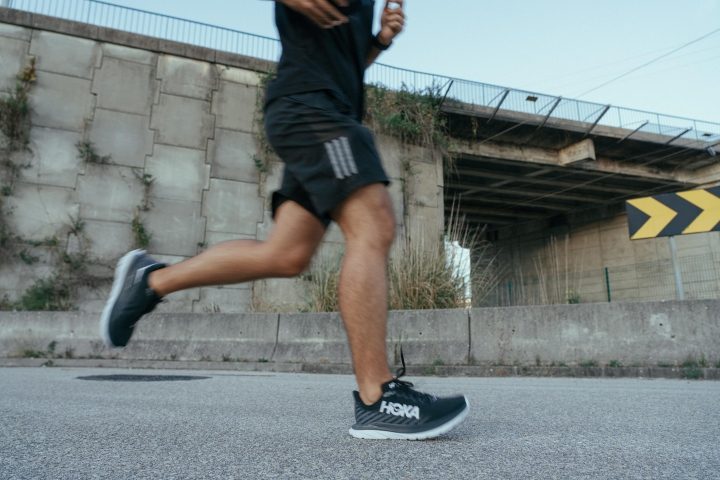
Why are Hoka shoes so expensive?
Based on our database, the average price of Hoka running shoes is £160 which is £20 more than running shoes across all brands on average.
We believe that Hokas are generally priced on the higher end for a few reasons:
- The brand invests heavily in research and development to create innovative designs and technologies, which contributes to higher production costs.
- They also prioritise quality materials like high-grade cushioning foams—and their shoes include a lot of cushioning.
- Finally, Hoka shoes have exploded in popularity over the last decade, contributing to their premium price tags.

Are Hoka shoes durable?
Hoka shoes are generally reputed for their solid durability. The brand utilises high-quality materials and construction techniques.
Hoka’s proprietary EVA midsoles hold up well over hundreds of miles. The outsoles of Hoka shoes feature durable rubber compounds and their trail shoes have Vibram lugs: the industry standard for both performance and durability.
In our lab, we put each Hoka shoe through a series of demanding tests to give you a better idea of which shoes excel in durability.
Here is the overview of the most durable road and trail running shoes from Hoka:
*Toebox and Heel padding durability are evaluated on a 1-5 scale where 5 is the most durable. As for the outsole, it's durability is measured by the dept of the dent caused by the Dremel - the lower number means more durable.

